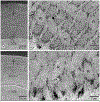Effects of Early Life Adversity on Tooth Enamel Formation
- PMID: 37034482
- PMCID: PMC10079274
- DOI: 10.3389/fdmed.2022.894753
Effects of Early Life Adversity on Tooth Enamel Formation
Abstract
In a systemic effort to survive environmental stress, organ systems fluctuate and adapt to overcome external pressures. The evolutionary drive back toward homeostasis makes it difficult to determine if an organism experienced a toxic exposure to stress, especially in early prenatal and neonatal periods of development. Previous studies indicate that primary human teeth may provide historical records of experiences related to stressors during that early time window. To assess the molecular effects of early life adversity on enamel formation, we used a limited bedding and nesting (LBN) mouse model of early life adversity (ELA) to assess changes in the enamel organ gene expression and enamel matrix mineralization. On average, postnatal day 12 (P12) ELA mice weighed significantly less than the controls. When adjusted for animal weight, ELA molar enamel volume was reduced as compared with the controls, and the relative mineral density of molar enamel was significantly increased. There were no obvious changes in enamel matrix crystal morphology or structure in ELA as compared with the control mouse enamel. RNAseq showed extracellular matrix organization to be the most significantly affected GO and reactome pathways, whereas butanote metabolism was the most significantly altered KEGG pathway. Transcripts expressing the enamel matrix proteins amelogenin (Amelx) and enamelin (Enam) were among the top 4 most differentially expressed genes. When evaluating molecular mechanisms for the changes in gene expression in ELA enamel organs, we found significantly increased expression of Dlx3, while transcripts for clock genes Per1 and Nrd1 were downregulated. These findings support the possibility that the developing enamel organ is sensitive to the pressures of early life adversity and produces molecular and structural biomarkers reflecting these challenges.
Keywords: RNAseq; ameloblasts; early life adversity (ELA); enamel; limited bedding and nesting (LBN); mineralization.
Conflict of interest statement
Conflict of Interest: The authors declare that the research was conducted in the absence of any commercial or financial relationships that could be construed as a potential conflict of interest.
Figures





References
-
- Davis KA, Mountain RV, Pickett OR, Den Besten PK, Bidlack FB, Dunn EC. Teeth as potential new tools to measure early-life adversity and subsequent mental health risk: an interdisciplinary review and conceptual model. Biol Psychiatry (2020) 87:502–13. doi: 10.1016/j.biopsych.2019.09.030 - DOI - PMC - PubMed
-
- Dunn EC, Mountain RV, Davis KA, Shaffer I, Smith ADAC, Roubinov DS, et al. Association between measures derived from children’s primary exfoliated teeth and psychopathology symptoms: results from a community-based study. Front Dental Med (2022) 3:803364. doi: 10.3389/fdmed.2022.803364 - DOI
Grants and funding
LinkOut - more resources
Full Text Sources
Molecular Biology Databases
